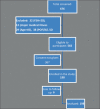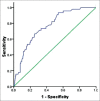Anti-mullerian hormone cut-off values for predicting poor ovarian response to exogenous ovarian stimulation in in-vitro fertilization
- PMID: 23162361
- PMCID: PMC3493837
- DOI: 10.4103/0974-1208.101023
Anti-mullerian hormone cut-off values for predicting poor ovarian response to exogenous ovarian stimulation in in-vitro fertilization
Abstract
Objectives: (a) To establish the cut-off levels for anti-Mullerian hormone (AMH) in a population of Indian women that would determine poor response. (b) To determine which among the three ie.,: age, follicle stimulating hormone (FSH), or AMH, is the better determinant of ovarian reserve.
Study design: Prospective observational study.
Setting: In vitro fertilization (IVF) unit of a tertiary hospital.
Materials and methods: The inclusion criterion was all women who presented to the center for in-vitro fertilization/Intracytoplasmic sperm injection (IVF/ICSI). The exclusion criteria were age >45 years, major medical illnesses precluding IVF or pregnancy, FSH more than 20 IU/L, and failure to obtain consent. The interventions including baseline pelvic scan, day 2/3 FSH, luteinizing hormone (LH), estradiol estimations, and AMH measurement on any random day of cycle were done. Subjects underwent IVF according to long agonist or antagonist protocol regimen. Oocyte recovery was correlated with studied variables. The primary outcome measure was the number of oocytes aspirated (OCR). Three categories of ovarian response were defined: poor response, OCR ≤ 3; average response, OCR between 4 and 15; hyperresponse, OCR > 15.
Results: Of the 198 patients enrolled, poor, average, and hyperresponse were observed in 23%, 63%, and 14% respectively. Correlation coefficient for AMH with ovarian response was r = 0.591. Area under the curve (AUCs) for poor response for AMH, subject's age, and FSH were 0.768, 0.624, and 0.635, respectively. The discriminatory level of AMH for prediction of absolute poor response was 2 pmoL/l, with 98% specificity and 20% sensitivity.
Conclusions: AMH fares better than age and FSH in predicting the overall ovarian response and poor response, though it cannot be the absolute predictor of non-responder status. A level of 2 pmol/l is discriminatory for poor response.
Keywords: Age; anti-Mullerian hormone; follicle stimulating hormone; poor ovarian response.
Conflict of interest statement
Figures
Similar articles
-
The addition of anti-Müllerian hormone in an algorithm for individualized hormone dosage did not improve the prediction of ovarian response-a randomized, controlled trial.Hum Reprod. 2017 Apr 1;32(4):811-819. doi: 10.1093/humrep/dex012. Hum Reprod. 2017. PMID: 28175316 Clinical Trial.
-
Ovarian response prediction in GnRH antagonist treatment for IVF using anti-Müllerian hormone.Hum Reprod. 2015 Jan;30(1):170-8. doi: 10.1093/humrep/deu266. Epub 2014 Oct 29. Hum Reprod. 2015. PMID: 25355590
-
Anti-Mullerian hormone is a better marker than inhibin B, follicle stimulating hormone, estradiol or antral follicle count in predicting the outcome of in vitro fertilization.Arch Gynecol Obstet. 2011 Jun;283(6):1415-21. doi: 10.1007/s00404-011-1889-7. Epub 2011 Mar 29. Arch Gynecol Obstet. 2011. PMID: 21562964
-
Circulating basal anti-Müllerian hormone levels as predictor of ovarian response in women undergoing ovarian stimulation for in vitro fertilization.Fertil Steril. 2009 Nov;92(5):1586-93. doi: 10.1016/j.fertnstert.2008.08.127. Epub 2008 Oct 18. Fertil Steril. 2009. PMID: 18930213 Clinical Trial.
-
Does the time interval between antimüllerian hormone serum sampling and initiation of ovarian stimulation affect its predictive ability in in vitro fertilization-intracytoplasmic sperm injection cycles with a gonadotropin-releasing hormone antagonist? A retrospective single-center study.Fertil Steril. 2013 Aug;100(2):438-44. doi: 10.1016/j.fertnstert.2013.03.031. Epub 2013 Apr 16. Fertil Steril. 2013. PMID: 23602319
Cited by
-
Semaphorin 3A Increases in the Plasma of Women with Diminished Ovarian Reserve Who Respond Better to Controlled Ovarian Stimulation.Life (Basel). 2024 Mar 8;14(3):358. doi: 10.3390/life14030358. Life (Basel). 2024. PMID: 38541683 Free PMC article.
-
Discordance between antral follicle counts and anti-Müllerian hormone levels in women undergoing in vitro fertilization.Reprod Biol Endocrinol. 2019 Jul 4;17(1):51. doi: 10.1186/s12958-019-0497-4. Reprod Biol Endocrinol. 2019. PMID: 31272468 Free PMC article.
-
Association between individual ovarian dimensions with ovarian reserve indices.EXCLI J. 2013 Jul 4;12:616-24. eCollection 2013. EXCLI J. 2013. PMID: 26966426 Free PMC article.
-
Reduced ovarian reserve in patients with adult polymyositis.Clin Rheumatol. 2015 Oct;34(10):1795-9. doi: 10.1007/s10067-015-3064-1. Epub 2015 Sep 7. Clin Rheumatol. 2015. PMID: 26345632
-
Diminished ovarian reserve in Behçet's disease patients.Clin Rheumatol. 2015 Jan;34(1):179-83. doi: 10.1007/s10067-014-2680-5. Epub 2014 May 31. Clin Rheumatol. 2015. PMID: 24878927
References
-
- Lim A, Psakok M. Age related decline in fertility: A link to degenerative oocytes. Fertil Steril. 1997;68:265–71. - PubMed
-
- Navot D, Rosenwaks Z, Margalioth EJ. Prognostic assessment of female fecundity. Lancet. 1989;2:645–7. - PubMed
-
- Scott RT, Jr, Hoffman GE. Prognostic assessment of ovarian reserve. Fertil Steril. 1995;63:1–11. - PubMed
-
- Loumaye E, Billion JM, Mine JM. Prediction of individual response to controlled ovarian hyperstimulation by means of a clomiphene challenge test. Fertil Steril. 1990;53:295–301. - PubMed
-
- Abdel Sattar N, Tharwak A. Ovarian reserve. Ain Shams Journal of Obstetrics and Gynecology. 2005;2:338–43.
LinkOut - more resources
Full Text Sources



